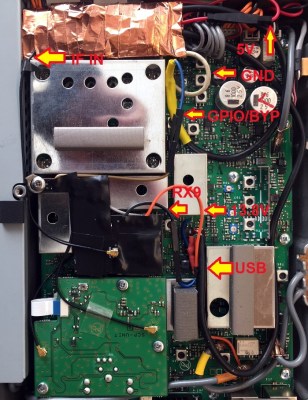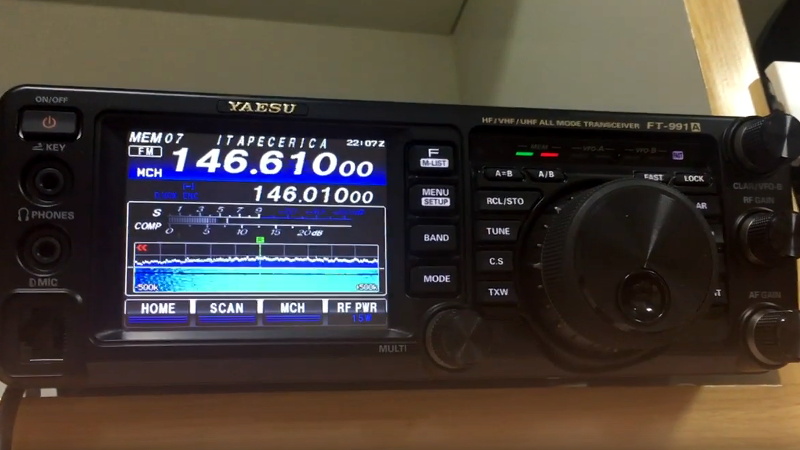We usually think of the RTL-SDR as a low-cost alternative to a “real” radio, but this incredible project spearheaded by [Rodrigo Freire] shows that the two classes of devices don’t have to be mutually exclusive. After nearly 6 months of work, he’s developed and documented a method to integrate a RTL-SDR Blog V3 receiver directly into the Yaesu FT-991 transceiver.
 The professional results of the hack are made possible by the fact that the FT-991 already had USB capability to begin with. More specifically, it had an internal USB hub that allowed multiple internal devices to appear to the computer as a sort of composite device.
The professional results of the hack are made possible by the fact that the FT-991 already had USB capability to begin with. More specifically, it had an internal USB hub that allowed multiple internal devices to appear to the computer as a sort of composite device.
Unfortunately, the internal USB hub only supported two devices, so the first order of business for [Rodrigo] was swapping out the original USB2512BI hub IC with a USB2514BI that offered four ports. With the swap complete, he was able to hang the RTL-SDR device right on the new chip’s pins.
Of course, that was only half of the battle. He had a nicely integrated RTL-SDR from an external standpoint, but to actually be useful, the SDR would need to tap into the radio’s signal. To do this, [Rodrigo] designed a custom PCB that pulls the IF signal from the radio, feed it into an amplifier, and ultimately pass it to the SDR. The board uses onboard switches, controlled by the GPIO ports on the RTL-SDR Blog V3, for enabling the tap and preamplifier.
In the video after the break, you can see [Rodrigo] demonstrate his modified FT-991. This actually isn’t the first time somebody has tapped into their Yaesu with a software defined radio, though this is surely the cleanest install we’ve ever seen.















Wicked Cool Hack !!!!!
Hey Yeasu – here’s a feature for whatever replaces the FT-991A
:-)
VK7FAZE
Since we’re on the topic of ham radio: I saw some 10W chinese transmitter kits for about 15$, a simple pcb with input for a morse key as well as microphone, the frequency is fixed though. I was wondering if that plus an sdr would be the cheapest ham radio starter kit, even though those 8W handhelds probably offer more functionality for a similar cost.
Hey Kris
You would certainly need a good signal switcher when you enter TX. I’m positive the RTL-SDR won’t accept very happily a few watts in its very sensible front-end (remember that RX stages works with microvolts (a fraction of milivolt).
You can find a few videos over the internet on fried front-ends because of bad, improper or failed signal isolation during a transmit.
\o
– RF.
Are you sure it had a microphone? Sounds like a “pixie” -which are morse (CW) only and very poor at both receiving and transmitting. They are a fun project for practising your soldering skills and making a radio that does “something”, but they are not all that useful. The cheapest way to DIY into HF ham radio with a practical, usable radio is likely either the QRPLabs CQX (CW only), and the UBitX (for voice/digital modes).
OK someone correct me if I am wrong on this, The SDR is grabbing the IF from the 991 and being used as a separate receiver? Other that working split, which I believe the radio can do natively, what would be the purpose? Not trying to poo poo the hack as I think it’s a great way to get a good clean single in to the SDR, just trying to wrap my head around other potential uses.
Hey Chris
A good and high resolution waterfall on your computer (SUPER useful when finding band activity)
The ability to click-and-tune (a huge win, the radio just show the activity and you have to tune over it)
More than double the bandwidth of the Radio Scope
The ability to dual watch
The ability to pipe the I/Q signal straight to GNURadio and decode digital signals on-the-fly without using audio and mixer ports
A few top of my mind ;-)
Cheers.
Thanks Rodrigo for sharing your project and enlightening me on it’s uses. The more I think about it I can visualize more ways that it can be useful/helpful.
Goid question.
In the past it wasn’t uncommin to tap into a receiver’s IF stage to add a panadapter (an oscilloscope tgat gave a visual presentation a but on either side of where tge receiver was tuned) or to add some external selectivity. There was a small and famous WWII receupiver that had good selectivity and tuned 455KHz, which was a common IF frequency at the time, and for twenty years that was an easy way to imorove a cheap receiver’s selectivity.
Even today, one if those USB SDR gizmos woukd be a way to add some level of SDR to an existing analog receiver, fir digital selectivity or adding other kinds of demodulation.
But since this rig already is SDR, the point dies seem less obvious. Tapped in tge right place, it would alliow for a second receive channel a bit off from the receiver’s frequency, but you say it can do that so it won’t do much.
Michael
Hey Michael!
Another FT-991/A interesting characteristic is that the IF tap is presented PRIOR to the roofing filters, meaning that the IF signal presented to the SDR encompasses the whole range preselected by the input BPF, In VHF, roughly 60 MHz wide (from 120 to 180 MHz). If the radio is tuned at 150 MHz, you get the signal of interest downconverted 30 MHz up and down from the center 69.450 MHz.
This is a bit extreme of course, but nonetheless… Possible.
The RX preselectors are, respectively:
HF – 0-65 MHz
VHF – 120 – 180 MHz
UHF – Has a quite a ripple, but it is roughly 430 – 540 MHz
For HF band, there are other subsequent BPFs in RX stage:
0.03 – 1.7
1.7 – 9.9
9.9 – 20.9
20.9 – 30
49 – 56
So theoretically, the IF tap signal is limited to the active band/preselector.
\o
– PY2RAF.
Awesome detail!
I was recently thinking again about a cost effective solution to better process signals into GRC for a more thorough and complete analysis regarding this situation that is finally back in the main stream media again: https://www.cbsnews.com/video/brain-trauma-suffered-by-u-s-diplomats-abroad-could-be-work-of-hostile-foreign-government-60-minutes-2019-09-01/
Definitely a big shout out to all those working on and dealing with these situations since we know not only foreign governments are capable of.
Any thoughts regarding down converting to an RTL-SDR and maybe using GRC or Spektrum for a wider bandwidth view or more likely HackRF using GRC or HackRF Spectrum Analyzer?
I’m almost thinking investing in an AD evaluation board for more functionality and quality… though the price is alarming. This presentation corrupted me: https://www.youtube.com/watch?v=RuJ0EOcN6dk
For a shoestring budget, I was and am still amazed what an RTL-SDR can do. Thanks for sharing.
Where and who can I send my radio too? 🤑
Hey Jud! HAHA!
Man if you were in Brazil I would happily refer you to the techie who did the job to me.
However, if you do have a tech of _great_ quality over there, you can just order the board, the materials in digi-key (it is all available in github), and get this techie to solder the board and implement it.
I could actually sell a Revision N board for you since I have a few spare components here, but unsure how to send your way. But thanks for your interest, I’m flattered! ;-D
73s – PY2RAF.
How did you secure the panadapter board to the radio? It looks like the hole is positioned directly above a screw, but that screw is quite a ways below the board.
I tried to change out the usb chip with a hot air rework station, but ended up cooking it (and probably the usb-serial converter below it), so I ended up just using the rs-232 for cat control for now. I’ve got more chips on the way so I’m gonna be trying again next week.
So far your light edition is working great. The only issue I’m having is that I can’t seem to reliably initiate a connection to Omni-rig probably due to just using jumper wires to my rs232-usb adapter. It looks like you’re using the same adapter as me, so if you have any tips about how to improve this connection, let me know.
73
KN4ZXN